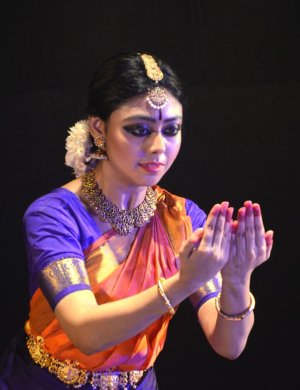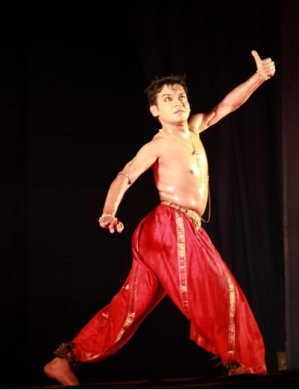
|   |

|   |
 e-mail: ukb7@rediffmail.com The pleasant and the poignant July 25, 2019 The enduring legacy of Indian classical dances has seen virtually a torrential flow in the post-Independence decades. One particularly strong stream has been the Pandanallur style of Bharatanatyam that -- taking off from an obscure village located over 200 km away from Chennai - had covered once some one-third of all the learners on the globe. It is part of history today that four particularly gifted brothers -- Chinnaiah, Ponniah, Sivanandam and Vadivel, all court composers in the early 19th century in Thanjavur -- created not merely ten dazzling Pada Varnams, which have lasted forever as masterpieces of Bharatanatyam, but also laid down the margam, a thoughtfully set-out sequence for presentation, which is still followed diligently by every practitioner. Among the illustrious gurus, first and foremost, Meenakshi Sundaram Pillai (related closely to the Thanjavur Quartet's family), then his son-in-law Chokkalingam Pillai, and finally his grandson, Subbaraya Pillai, were the doyens of the Pandanallur form, beginning from the last quarter of the 19th century up to the very early 21st century. Along with a few more stalwarts, these gurus kept the flag up for the form, grooming -- among themselves -- almost everybody who was and is anybody for this style: from Ram Gopal, Mrinalini Sarabhai, Rukmini Devi Arundale, Indrani Rehman, US Krishna Rao and Chandrabhaga Devi, up to teaching at Kalakshetra and continuity of their tradition through Yamini Krishnamurthy, Alarmel Valli and Jamuna Krishnan, among a zillion others. It is salutary to remember this glorious continuity of heritage if one wishes to trace the lasting excellence of the form: the major emphasis on linear geometry found in the adavu technique; the intensity and understatement in abhinaya; valuable jatiswarams (in ragas like Vasantha, Saveri, Chakravakam, Kalyani and Bhairavi), which incorporate abstract adavu choreography for the swara passages; strong footwork where every step is marked yet foot-stomping is a taboo; and a natural rhythmic body of expression. Today, if one closely observes continuity from the iconic dancer Yamini Krishnnamurthy to her hugely gifted disciple Rama Vaidyanathan, and now, from Rama to her gifted, Delhi-based daughter Dakshina Vaidyanathan as well as the virtuoso, Kolkata-based dancer Sayani Chakraborty, one can almost discern the emergence of a new Pandanallur gharana, thanks to the continuity of an assiduous blending of training and talent through three generations. Ghanashyam The season of monsoon witnesses the gathering of the dark clouds in the sky. The inky blue hue of the firmament creates a sense of wonder, joy and excitement in the hearts of all earthly creatures that have been listlessly waiting for the rains. The parched earth suffering through the long summer months is now in a celebratory mood, finding expression as the longing of lovelorn maids for Krishna in many a poet's lyrical outpourings.  Sayani Chakraborty Ghanashyam presented on July 14 by Sayani, was woven around the theme of the dark lord Krishna, as seen and remembered through the darkened days of Varsha. Weaving a garland of Margam, she began with Alarippu in an exposition of Chatusra rhythm. Thematically it visualized a maiden in sringara adorning herself for receiving her beloved, much like the earth with its eagerness to receive the rains. The Alarippu concluded with a sloka from Kalidasa's Ritusamhara: The vault of heaven is overly impregnated with massive clouds that are similar to the gleam of blackish petals of dark blossoms... somewhere they are similar to the glitter of the heaps of well-kneaded black mascara... and elsewhere they glisten like the blackened nipples of bosoms of the pregnant woman, ready to rain the elixir of life on the lips of her offspring... This was followed by a Meera bhajan Aaj suni main Hari awan ki awaz..., set to ragas Megh, Mian Malhar and Jyjayanti, and in adi taal. The composition was used as an elaborate Varnam to include jathis, chittaswaram and aradhis, where Meera exalts: Today I perceive the signs of Hari's arrival. Today, as the dark clouds gather, they announce the arrival of my Dark One. Today, in the dance of the peacock, in the wind that blows through trees, and in the rain drops that quench the parched earth, I see his messenger. Today, in the lashing of the rain and blowing of the breeze, I hear his voice... Next was a scintillating padam by Swati Thirunal, where the Khandita Nayika has been waiting to receive her beloved. Discovering that he has spent time with another woman, she vents her anger and anguish in sarcasm. Finally reprimanding him, she discovers her strength in herself. Set in raga Subha Pantuvarali and mishra chapu tala and beautifully choreographed by Rama Vaidyanathan, the dance portrayed myriad emotions of a nayika who feels dejected and hurt. The finale was a tillana in raga Behag and chatushra eka tala. As a celebration of rain, it portrayed the joy and exuberance of nature along with all living creatures. All through, displaying the abstract austerity of adavus, exactness and accuracy to bring out the dance's rhythmic vitality, and a sensibility to catch musical lyricism, Sayani caught the quintessence of Pandanalur style as honed by her guru. The accompanying support was brilliant, with vocals by Durba Singha Roychoudhury, mridangam by Shankar Narayanswamy and flute by Rupak Mukherjee, while on nattuvangam was Vandana Alase. Shikhandi The other artiste who shared the evening platform with Sayani was Himanshu Srivastava, a Delhi-based Bharatanatyam dancer and an accomplished painter. A senior disciple of Dr. Saroja Vaidyanathan and Rama Vaidyanathan, he opened with Kalabhairav Ashtakam, a composition of Adi Shankaracharya, set to music by S. Vasudevan in raga Mishra Bahar, which portrayed the holy deity in a magnificently Vichitra Bhairava form.  Himanshu Srivastava Shikhandi - the Inner Quest, the main presentation, conceived and choreographed by Himanshu, was the well-known story culled from the Mahabharata, about the transgender figure who got his gender converted by a shape-shifting Yaksha. The plot begins with a mortified Shikhandi asking Krishna his sole aim of existence as he feels dejected at the height of the Kurukshetra battle. Krishna -- the epitome of our own inner self -- reminds Shikhandi of his previous birth as Princess Amba. Recalling the story in a flashback, Shikhandi re-lives the abduction by Bhishma from the Swayamvara; the hardships Amba had faced because of the Kaurava patriarch Bhishma; and her solemn pledge to destroy Bhishma. Confident, she jumps into the battleground and fights to a victorious end. This complex story was well marked with thoughtfully-conceived recorded music and Sanskrit chant (both by Sridhar Vasudevan). Koham bruhime Krishna?.. echoed through the raga Charukeshi to reflect Shikhandi's longing for acceptance. Karma dharma kurukshetre sthitah... epitomised his plight, with both the armies laughing at his confused gender identity. Amba's Swayamvara had elements of Avanti folk music, shehnai, mangalgeet (wedding song) and swastibachan all adapted to the classical style. While Amba's tale of agony was portrayed over flute, Dhaata vidhaata kon gangeya... were her last words before she immolated herself to be reborn. Avanti folk music sohar (childbirth song) was heard again to express the king's dismay hearing the news of a girl child born. Later, the daughter had her gender changed by a Yaksha: yakshena striya purushena parivartitaa... Post flashback, two curtains - pink and blue -- swayed in the mid-stage signifying the two distinct genders and, in that space, Shikhandi danced opening before the viewers multiple possibilities of gender fluidity. Himanshu's choreography was precise and praiseworthy but needed some pruning, to avoid fatigue in ekaharya abhinaya for well over an hour. Moreover, his costume warranted a symbolic change to emphasize male and female roles. Though he could not possibly do this due to his supposed presence in the battleground, both during flashback and flash-forward sequences, an imaginative use of a dupatta over the head or, otherwise, as a belt, could have achieved the same purpose, instead of dancing on in a bare-bodied torso throughout. The moral of the parable was clear though. For Shikhandi, it was a sojourn through multiple births and finally he made peace with the masculine and the feminine entities, both coexisting within him. Uttishtha, jaagrita..., he told himself ... for the soul is free of gender... But has that battle for acceptance ended for him in modern times? Is he still around fighting for strength, valor and recognition? Has he found the self-realization that he sought so desperately from Krishna?  Dr. Utpal K Banerjee is a scholar-commentator on performing arts over last four decades. He has authored 23 books on Indian art and culture, and 10 on Tagore studies. He served IGNCA as National Project Director, was a Tagore Research Scholar and is recipient of Padma Shri. Post your comments Please provide your name and email id when you use the Anonymous profile in the blog to post a comment. All appropriate comments posted with name & email id in the blog will also be featured in the site. |